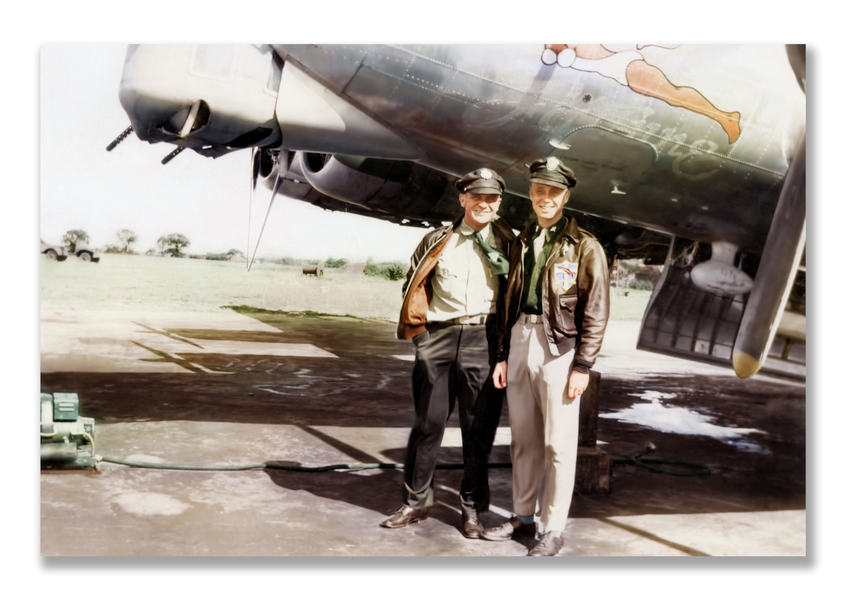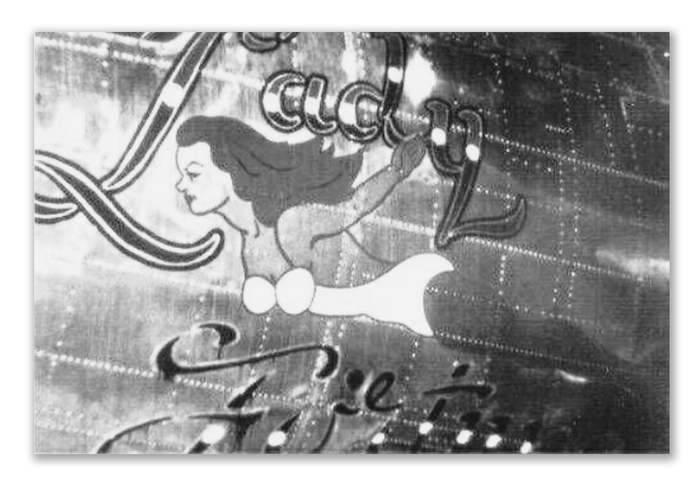|
Lt. General Jimmy Doolittle (Commander of the 8th Air Force) & my father Lt. Ernest Anders Erickson standing below the B-17 "Lady Fortune" (42-97858), formerly called "Carmenís Folly" at Horham Airfield in England in the Summer of 1944. With the paint air compressor visible on the left of the photograph and the "step box" sitting behind my father, the painter of the Lady Fortune has a work-in-progress going on the nose art and very likely snapped this photograph. "Lady Fortune" was assigned to the 100th Bomb Group on April 30th, 1944 at the Royal Air Force station Thorpe Abbotts located 4 miles (6.4 km) east of Diss, Norfolk, England. The ship was later transferred to the 95th Bomb Group - 334th Squadron on May 1st, 1944 at Horham. The airfield lies next to the village of Horham. Designated as Station 119 by the Air Corps, it was located 4 miles southeast of Eye in Suffolk. The airfield and base straddled the parishes of Denham, Horham, Redlingfield and Hoxne. Lady Fortune's luck ran out on January 10th, 1945 when it sustained serious damage due to flak and went down during a combat mission over Cologne, Germany. Six crewmen were killed and three were captured and spent the rest of the war in a prisoner of war camp. Below the photograph is a biography on Jimmy Doolittle, concentrating on his activities between 1941 through 1945. |


© Mark Erickson 2017 All rights reserved.
This copyrighted material may not be republished without permission.
Contact via Email @ Mark Erickson or visit his website @
http://markerickson.com/Family_History
Links are encouraged.
|
James Harold "Jimmy" Doolittle was an American aviation pioneer. A Reserve officer in the United States Army Air Corps, Doolittle was recalled to active duty during World War II and awarded the Medal of Honor for his valor and leadership as commander of the Doolittle Raid, a bold long-range retaliatory air raid on the Japanese main islands months after the Attack on Pearl Harbor. He was eventually promoted to lieutenant general and commanded the Twelfth Air Force over North Africa, the Fifteenth Air Force over the Mediterranean, and the Eighth Air Force over Europe. Following the reorganization of the Army Air Corps into the Air Force in June 1941, Doolittle was promoted to Lieutenant Colonel on January 2, 1942, and assigned to Army Air Forces Headquarters to plan the first retaliatory air raid on the Japanese homeland. He volunteered for and received General Hap Arnold's approval to lead the top secret attack of sixteen B-25 medium bombers from the aircraft carrier USS Hornet, with targets in Tokyo, Kobe, Yokohama, Osaka and Nagoya. After training at Eglin Field and Wagner Field in northwest Florida, Doolittle, his aircraft, and flight crews proceeded to McClellan Field, California for aircraft modifications at the Sacramento Air Depot, followed by a short final flight to Naval Air Station Alameda in California for embarkation aboard the aircraft carrier USS Hornet. On April 18, the bombers took off from the Hornet, reached Japan, and bombed their targets. Fifteen of the planes then headed for their recovery airfield in China, while one crew chose to land in Russia due to their bomber's unusually high fuel consumption. As did most of the other crewmen who participated in the mission, Doolittle's crew bailed out safely over China when their bomber ran out of fuel. By then they had been flying for about 12 hours, it was nighttime, the weather was stormy, and Doolittle was unable to locate their landing field. Doolittle came down in a rice paddy near Chuchow (Quzhou). He and his crew linked up after the bailout and were helped through Japanese lines by Chinese guerrillas and missonaries. Other aircrews were not so fortunate. Although most eventually reached safety with the help of friendly Chinese, four crew members lost their lives as a result of being captured by the Japanese and three due to aircraft crash or while parachuting. Following the raid, Doolittle went on to fly more combat missions as commander of the 12th Air Force in North Africa, for which he was awarded four Air Medals. The other surviving members of the raid also went on to new assignments. Doolittle received the Medal of Honor from President Franklin D. Roosevelt at the White House for planning and leading his raid on Japan. His citation reads: "For conspicuous leadership above and beyond the call of duty, involving personal valor and intrepidity at an extreme hazard to life. With the apparent certainty of being forced to land in enemy territory or to perish at sea, Lt. Col. Doolittle personally led a squadron of Army bombers, manned by volunteer crews, in a highly destructive raid on the Japanese mainland." The Doolittle Raid is viewed by historians as a major morale-building victory for the United States. Although the damage done to Japanese war industry was minor, the raid showed the Japanese that their homeland was vulnerable to air attack, and forced them to withdraw several front-line fighter units from Pacific war zones for homeland defense. More significantly, Japanese commanders considered the raid deeply embarrassing, and their attempt to close the perceived gap in their Pacific defense perimeter led directly to the decisive American victory during the Battle of Midway in June 1942. When asked from where the Tokyo raid was launched, President Roosevelt coyly said its base was Shangri-La, a fictional paradise from the popular novel Lost Horizon. In the same vein, the U.S. Navy named one of its Essex-class fleet carriers the USS Shangri-La. In July 1942, as a brigadier general, Doolittle had been promoted by two grades on the day after the Tokyo attack, by-passing the rank of full colonel. Doolittle was then assigned to the Eighth Air Force. This followed the rejection of his name by General Douglas MacArthur as commander of the Southwest Pacific Area to replace Major General George Brett. Major General Frank Andrews first turned down the position, and, offered a choice between George Kenney and Doolittle, MacArthur chose Kenney. In September, Doolittle became commanding general of the Twelfth Air Force, soon to be operating in North Africa. He was promoted to major general in November 1942, and in March 1943 became commanding general of the Northwest African Strategic Air Force, a unified command of U.S. Army Air Force and Royal Air Force units. In September, he commanded a raid against the Italian town of Battipaglia that was so thorough in its destruction that General Carl Andrew Spaatz sent him a joking message: "You're slipping Jimmy. There's one crabapple tree and one stable still standing." Major General Doolittle took command of the Fifteenth Air Force in the Mediterranean Theater of Operations in November 1943. On June 10th, he flew as co-pilot with Jack Sims, a fellow Tokyo Raider, in a B-26 Marauder of the 320th Bombardment Group, 442nd Bombardment Squadron on a mission to attack gun emplacements at Pantelleria. Doolittle continued to fly, despite the risk of capture, while being privy to the Ultra secret, which was that the German encryption systems had been broken by the British. From January 1944 to September 1945, he held his largest command, the Eighth Air Force in England as a lieutenant general, his promotion date being March 13, 1944 and the highest rank ever held by an active reserve officer in modern times. |
h o m e